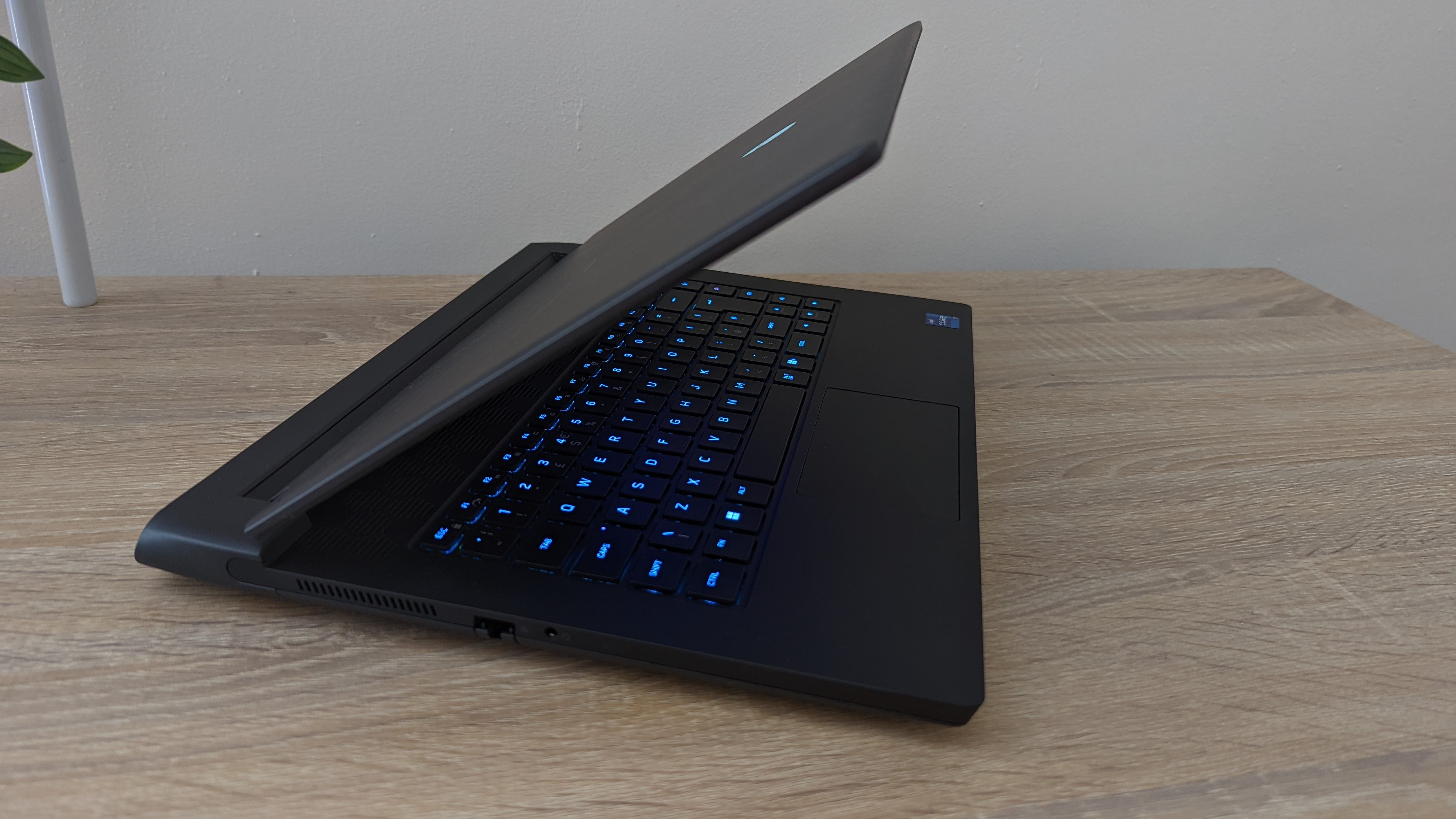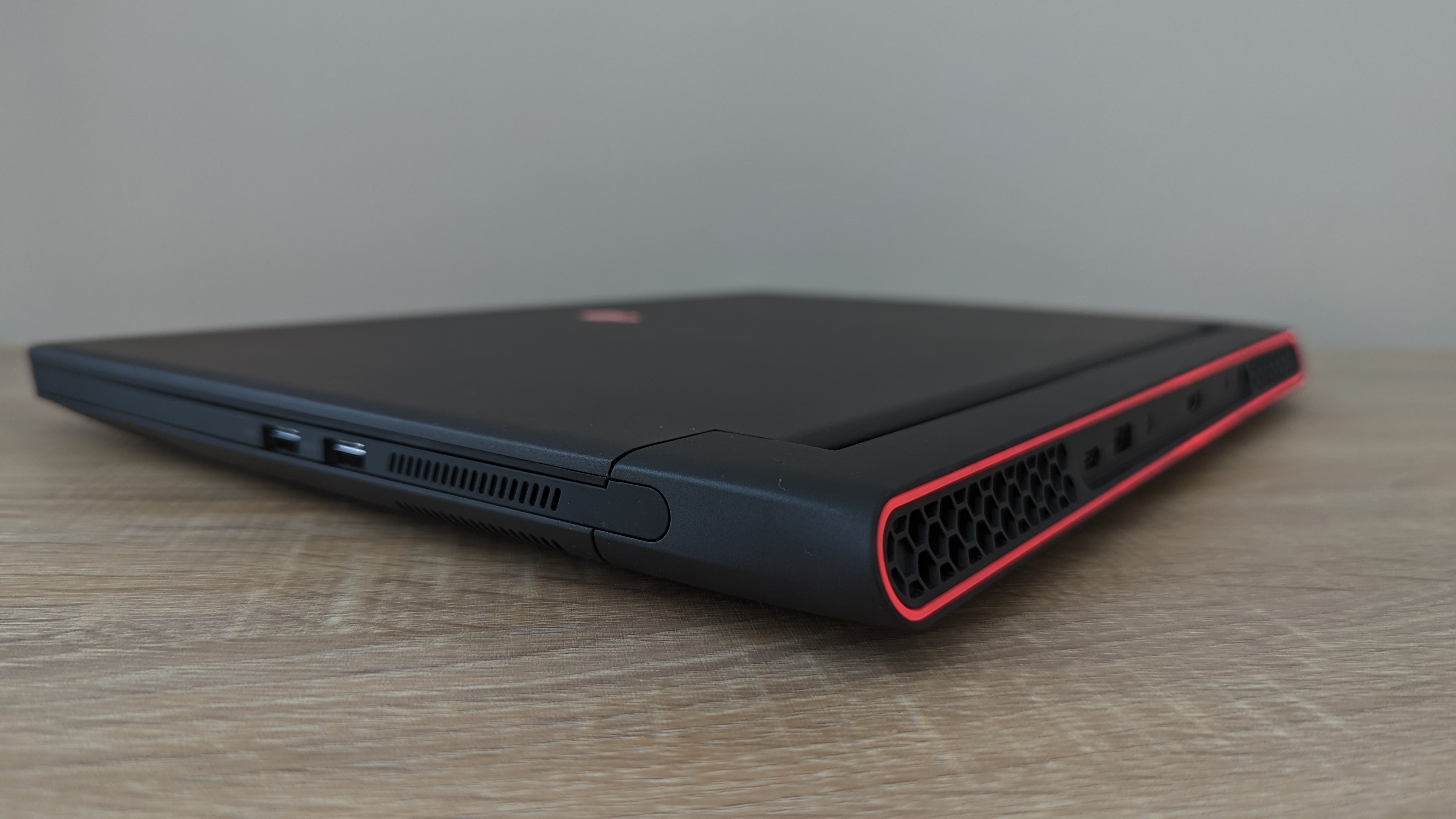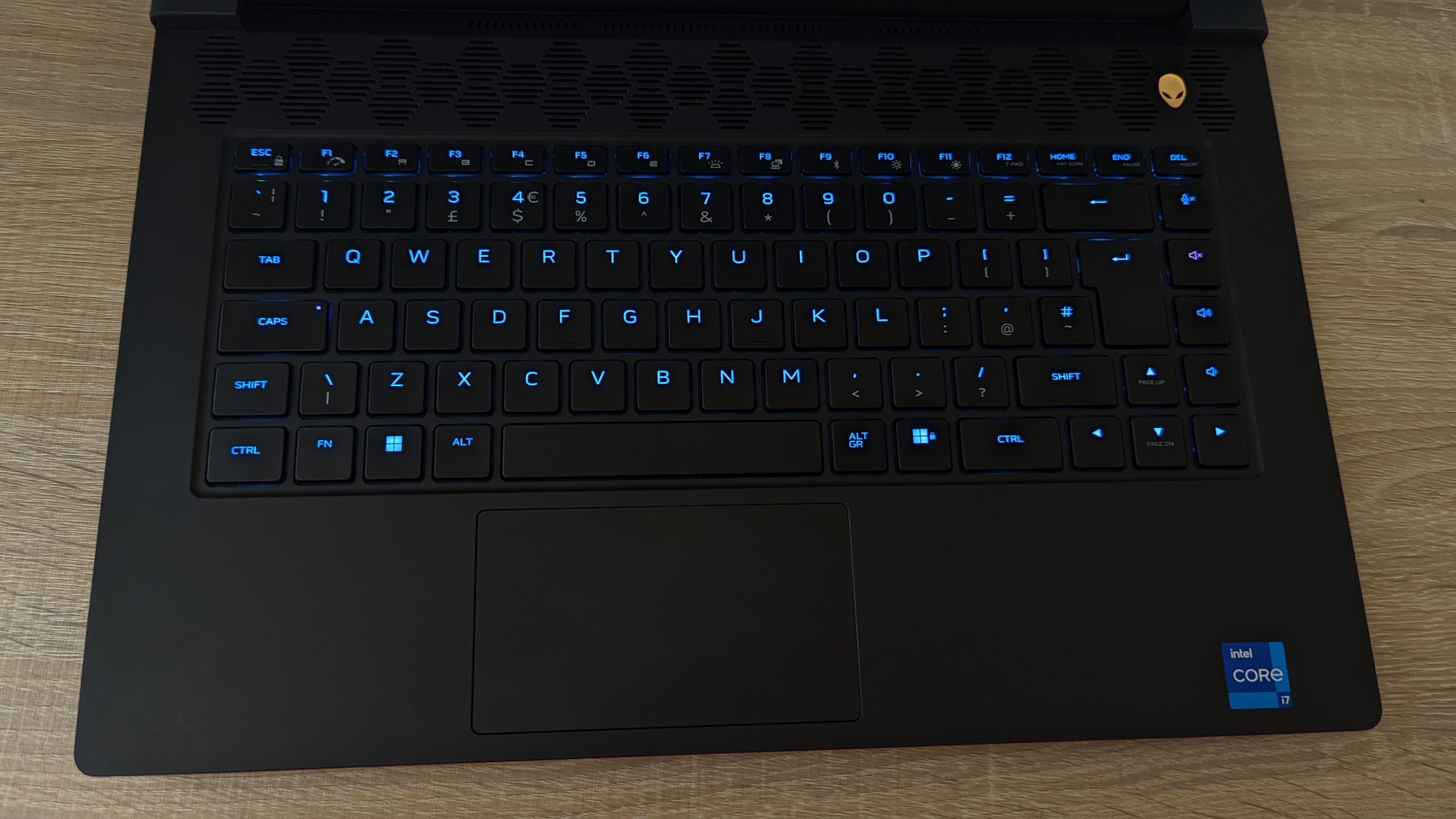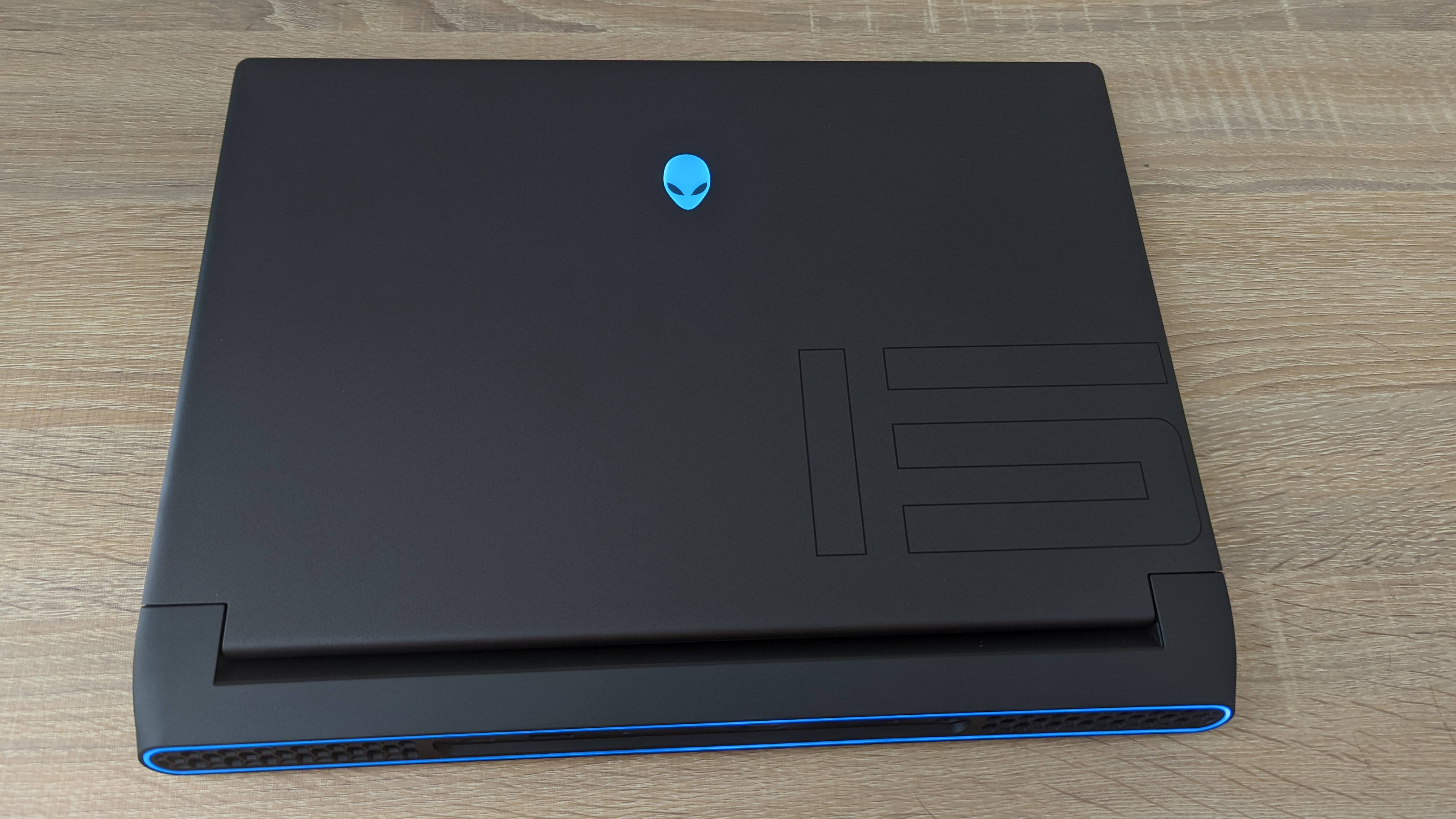Alienware M15 R7: Two-Minute Review
Dell’s Alienware gaming laptops can be a very mixed bag. With an almost ridiculously huge range of models available, there’s always going to be some chaff that needs to be separated from the (admittedly more plentiful) wheat. Thankfully, the new Alienware M15 R7 sits firmly in the cereal grain category – a well-rounded 1080p gaming machine with a shiny 12th-gen Intel processor at its core.
At first glance, the M15 R7 is the same as almost every other Alienware laptop released in recent years; an indented screen hinge, a long ring of RGB lighting along the rear edge, and that iconic alien-head logo illuminated in vivid blue. It’s a tried-and-tested design that we can’t blame Dell for sticking with – after all, if it ain’t broke, don’t fix it.
That being said, at first glance there’s perhaps one area Dell could’ve improved things here – and it’s not actually on the laptop itself. The main chassis weighs about two and a half kilograms and its 15.6” display means that it’s not the most portable laptop out there, but our real beef is with the huge, heavy power adaptor. Since the battery life is unimpressive, you’ll need to lug this brick around with you in addition to the laptop itself, rendering the Alienware M15 R7 decidedly less-than-lightweight.
The overall design is a bit cheaper than Alienware’s other X-series laptops (like the Alienware X14 we saw earlier this year), with more plastic used in its outer construction, so it doesn’t feel quite as durable as some other models – though this does come with an associated reduction in price.
Still, this gaming laptop very much sits in the premium product category, with even the most affordable model costing a tidy $1,499. It’s heavily configurable on Dell’s website, though, so you should be able to find an Alienware M15 R7 to fit your budget – provided you can breach that entry price.
Naturally, gaming performance is great thanks to plenty of RAM and an RTX 3000-series graphics card. It’s a good thing too; one of the big draws here is the 1080p display’s uber-fast 360Hz refresh rate, a love letter to esports gamers for whom framerate is king.
Does this new Alienware M15 R7 deserve to climb the ranks and make it onto our coveted list of the very best gaming laptops? We think it’s in with a good chance; even if it is more of a desktop replacement than a portable gaming machine.

Alienware M15 R7: Price and Availability
- Starting price of $1,499
- Version tested costs $2,350
- Wide range of models going all the way up to $4,045
Spec Sheet
Here is the Alienware M15 R7 configuration sent to TechRadar for review:
CPU: Intel Core i7-12700H
Graphics: Nvidia GeForce RTX 3070 Ti
RAM: 32GB DDR5-4800
Screen: 15.6-inch 1920×1080, 360Hz, 1ms
Storage: 1TB PCIe SSD
Ports: 2x USB-A 3.2 Gen 2, 1x USB-A 3.2 Gen 1, 1x Thunderbolt 4, 1x HDMI 2.1, RJ-45 Ethernet, combi audio jack
Connectivity: Wi-Fi 6E, Bluetooth 5.2
Camera: 720p webcam
Weight: 2.61 kg
Size: 2.4 x 35.6 x 27.3 cm
The Dell website allows US and UK buyers to select from a massive range of possible configurations, essentially building your preferred Alienware M15 R7 before proceeding to the checkout. This feature is present on the Australian website too, albeit with a far more limited selection.
The most budget-friendly option comes with an Intel Core i9-12700H, RTX 3050 Ti, 16GB of DDR5, and half a terabyte of SSD storage. Clocking in at $1,499 (£1,399), this model also has a more refrained refresh rate on its display, a still-respectable 165Hz. It’s a lot of money for the given specs.
We’d actually be inclined to say that the model we were sent for review is better value for money, costing $2,350 (inexplicably more expensive in the UK at £2,479) but offering a much more powerful RTX 3070 Ti, double the RAM and storage, and that super-speedy 360Hz display. This exact version isn’t available in Australia, but a comparable model with a 1440p screen costs AU$4,505.
The highest-spec model possible uses an RTX 3080 Ti along with an AMD Ryzen 6900HX processor, 64GB of memory, and 4TB of storage. With Windows 11 Pro and Alienware’s other bells and whistles, this version costs a whopping $4,045 and is only available in the US.
- Price and availability: 3/5

Alienware M15 R7: Design
- Bright, super-fast display
- Plastic feels a little cheap in some places given the price
- Keyboard is good
As we mentioned above, the overall design hasn’t changed much here. The Alienware logo still sits illuminated by RGB LEDs on the back of the screen, while another doubles as the power button; a large ‘15’ etching dominates a quarter of the lid, and the hexagon-patterned grille for the speakers and air intake still sits above the keyboard.
All this is fine – it’s become an iconic design for Dell’s gaming laptop brand over the past few years, and while we’d be happy to see it shaken up a little, it’s still aesthetically sound. The all-plastic chassis feels a tad cheap (more of a problem if you opt for one of the $3,000+ models) but the matte finish looks good and does a great job of repelling fingerprints.
Naturally, the 360Hz display is a defining feature of the Alienware M15 R7, and we’re pleased to say that it’s just a good screen all around. Maximum brightness is good, and color reproduction – while perhaps not the absolute best we’ve seen in a gaming laptop – is vivid and clear. A 1440p version with a 240Hz refresh rate is available on certain SKUs, if higher resolution is more important to you.
The keyboard is pretty good, with a nice amount of travel (about 1.8mm) on the keys meaning that mistypes are kept to a minimum. There’s a tiny amount of flex in the keyboard if you press very firmly on the keys in the center, but that’s not surprising given the plastic construction. The trackpad is a bit on the smaller side, but it’s very responsive and you’ll likely be connecting a mouse for gaming anyway.
We’ve got Wi-Fi 6E and Bluetooth 5.2 built-in, a new standard inclusion for gaming laptops these days. In terms of physical connectivity, there are three USB-A ports, RJ-45 Ethernet, HDMI port, headphone jack, and a Thunderbolt 4 port – though be aware that the latter is replaced by a regular USB-C on the cheapest 3050 Ti models.

Alienware M15 R7: Performance
- Amazing for 1080p gaming
- Thermal performance is very good…
- …but the fans are very loud as a result
Benchmarks
Here’s how the Alienware M15 R7 performed in our suite of benchmark tests:
3DMark Night Raid: 42,028; Fire Strike: 24,099; Time Spy: 10,852
Cinebench R20 multi-core: 6,311
GeekBench 5: 1,762 (single-core); 13,447 (multi-core)
PCMark 10 (Modern Office): 7,569
PCMark 10 (Battery life test): 3 hours and 4 minutes
TechRadar Battery Life Test: 3 hours and 59 minutes
Total War: Warhammer III (1080p, Ultra): 78 fps; (1080p, Low): 202 fps
Cyberpunk 2077 (1080p, Ultra): 81 fps; (1080p, Low): 116 fps
Dirt 5 (1080p, Ultra): 76 fps; (1080p, Low): 173 fps
Unsurprisingly, the RTX 3070 Ti powering our review model of the Alienware M15 R7 absolutely dominated in gaming benchmarks at 1080p Ultra settings, comfortably clearing 60 fps in anything we threw at it. Esports titles like Valorant and CS:GO should make good use of that 360Hz refresh rate, with framerates easily reaching into the hundreds.
Ray-tracing in Cyberpunk 2077 saw our performance take a hit, but it shouldn’t take much tweaking in the settings to dial your graphics down a little and remain above 60 fps. If you opt for a model with the 1440p display, we’d advise sticking with the RTX 3070 Ti or 3080 Ti, since the lower-powered GPUs are likely to struggle a bit more at this resolution (though DLSS is still an option, of course).
Synthetic benchmarks offered solid performance too, with the RTX 3070 Ti storming through the suite of 3DMark tests with excellent results. Intel’s nifty performance/efficiency core design, found in the i7-12700H at the heart of this system, means that CPU-bound tests like GeekBench 5 also saw impressive figures.
The thermal design at play here is definitely solid, as the chassis never got more than a bit warm (never uncomfortably hot) and we didn’t see any significant component throttling even during stress testing. If you look after it, the Alienware M15 R7 should last for years without thermal issues degrading the lifespan of its internals.
Of course, the tradeoff for this top-notch heat dissipation is a pair of extremely loud fans, among the noisiest we’ve seen in our many years of testing gaming laptops. Setting it to ‘high-performance mode’ made us worry that it was about to take off and blast a hole in our office wall, but the fans would even kick in with a noisy whine during basic tasks like browsing Chrome or digging through the Windows settings. In short: invest in a good headset.

Alienware M15 R7: Battery Life
- Fine, but unimpressive
- Enough to watch a movie, at least
- Lots of RGB that must be turned off
Gaming laptops are hardly renowned for their long battery life, but the 89Whr battery that powers the Alienware M15 R7 is decidedly lackluster. The laptop lasted barely more than three hours in the PCMark 10 battery life test, and that was with all the extraneous RGB lighting shut off to conserve power.
Video playback fared a little better, almost reaching four hours, meaning that you should at least be able to watch a movie without needing to plug in provided you start with a full charge. Gaming, though, is unlikely to give you anything more than 2 hours before you need to connect that hefty AC adaptor. Sure, plenty of gaming laptops are exactly the same, but we’ve still seen better.
Buy it if…
Don’t buy it if…
Also consider…
First reviewed July 2022
We pride ourselves on our independence and our rigorous review-testing process, offering up long-term attention to the products we review and making sure our reviews are updated and maintained – regardless of when a device was released, if you can still buy it, it’s on our radar.




